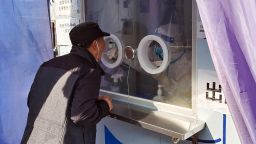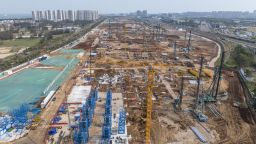As much of the world fights desperately to bring down soaring prices that are slashing living standards, China is trying to do the opposite.
Consumer prices rose by just 0.7% in March, compared with a year earlier. Factory gate prices fell for the six month in a row. In America, meanwhile, consumer price inflation was still 5% last month despite falling sharply; in the European Union it was 8.3% and in the United Kingdom 10.1%.
Prices are stagnating or falling in China despite the fact that the People’s Bank of China (PBOC) has been cutting interest rates and pumping cash into the financial system to bolster the economy, and despite the removal of strict Covid control measures late last year.
Uncertainty over the economy means Chinese households continue to stash money into savings rather than going out to spend, and companies remain wary of making new investments. That’s raising the specter of a tailspin of falling prices and wages from which the economy may struggle to recover.
“Our core view is that China’s economy is deflationary,” wrote Raymond Yeung, chief economist for Greater China at ANZ Research, last week, soon after China released its first-quarter GDP growth figures.

Although GDP expanded 4.5% in the first quarter, that growth largely reflected the impact of pent-up demand among shoppers following three years of pandemic restrictions, Yeung added. Stripping that out, GDP growth would have been only 2.6%.
There’s plenty of money in the economy. The broad money supply, as measured by M2, increased by a record high of $5.6 trillion in the past 15 months. And the PBOC has been trying to encourage people to spend by boosting banking liquidity via multiple policy tools, such as open market operations and lowering reserve requirement ratios.
But consumers appear to have barely reacted. Instead of spending money, people are hoarding cash at a record rate. Much of the new bank lending has gone to local governments, which were used to repay their high levels of debt, according to analysts.
The unusual combination of price declines and unprecedented money supply in the economy has fueled talk of deflation.
Deflation ‘has begun’
Deflation is defined as a sustained and broad decline in general price levels for goods and services over a period of time.
It’s bad for the economy because, in such an environment, consumers and companies may put off spending in anticipation of prices falling further, which would only exacerbate economic problems.
The problem plagued Japan’s stagnant economy for two decades, and its officials have only recently succeeded in starting to reverse the trend.
“To describe China’s current economic situation in a word, deflation has begun, and the economy has fallen into recession territory,” said Liu Yuhui, a professor with a top government think tank, the Chinese Academy of Social Sciences (CASS), during a recent speech that was widely circulated on social media.
The pulse of the real economy is still “weak,” as real estate prices and financial assets “have not risen,” he added.
Chinese households are heavily in debt and have no ability or willingness to spend, he said. Local governments, whose finances have been decimated by a combination of the real estate crash and the pandemic, are also acting like “zombies” because of their debt woes.
“Due to the personal balance sheet issue … the willingness to use credit by various subjects in the entire economic system is rapidly collapsing,” Liu said.
“The current China is the United States [of] 15 years ago, and Japan 30 years ago,” he added.
Cash handouts?
Yu Yongding, a former director of the Institute of World Economics and Politics at the CASS, expressed a more cautious view. But he admitted that the economy was facing deflationary pressure.
“In my opinion, although the statement ‘deflation has begun’ is not necessarily accurate, it is not a big mistake. Calling attention to deflation is entirely correct,” he wrote in an article posted last week on the Chinese news site Netease. “Insufficient aggregate demand is a prominent problem facing the economy.”
A former central bank adviser, meanwhile, has urged Beijing to give cash handouts to consumers to stoke demand — a measure that was adopted by many major economies, such as the United States and Australia. But it has been rarely used by China’s central government.
Li Daokui, a professor of economics at Tsinghua University who had served on the PBOC’s advisory committee, called on Beijing to hand out 500 billion yuan ($72.5 billion) in consumption vouchers to spur spending for the rest of this year.
“Even with a conservative estimate, 500 billion yuan in consumption vouchers will drive one trillion yuan in overall consumption, ” Li said in a video posted on his Weibo social media account on Tuesday.
In return, the government could receive at least 300 billion yuan through taxes generated by the increase in spending, he said
“So it only takes 200 billion yuan in spending for the central government to drive one trillion yuan in consumption,” he said. “So why not do it? “
For its part, the PBOC has dismissed talk of deflation and defended its current policies.
“There is no basis for long-term deflation or inflation,” said Zou Lan, an official with the PBOC, at a news conference in Beijing last Thursday.
“As the financially supportive policies take effect, consumer demand is expected to warm up and price increases are likely to return to the average levels of previous years in the second half of this year,” he said.










